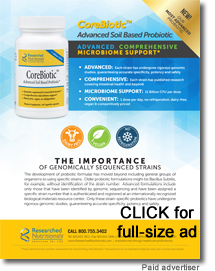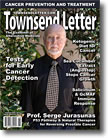|
Page 1, 2
Many of my patients have benefitted from Salicinium®, a glyco benzaldehyde that is a viable immune system enhancer. Salicinium has a unique mechanism of action, which I will explain throughout this article. I will also provide a case study, where a male patient, WW, received his initial treatment with Salicinium in May of 2014 for diagnosis of prostate cancer. This previous prostate diagnosis was alleviated as was determined by his oncologist through biopsy. As noted in previous articles in the Townsend Letter, which appeared in the August/September 2013, 2014, 2015, and 2016 issues, the efficacy of Salicinium is well documented. It has been my experience and that of other doctors who have used it in thousands of patients that it is highly effective as an immune-enhancing substance. Much of the evidence supporting Salicinium's effectiveness is derived from its extensive use in clinical practice as well as from tests that labs have performed on its mechanism of action.
 Salicinium is a natural glyco benzaldehyde. It is the smallest and simplest of all known sugar/benzaldehydes in nature. There have been other benzaldehydes used in cancer such as glyco benzylidene extracted from the Japanese fig,1 but this molecule was so difficult to extract it had to be synthesized. The synthesized version could not be made to last more than 36 hours and so fell out of favor in most of the world. The above study shows the superiority of a glyco benzaldehyde molecule such as Salicinium being taken up by both bacteria and anaerobic mammalian cells. Salicinium is a natural glyco benzaldehyde. It is the smallest and simplest of all known sugar/benzaldehydes in nature. There have been other benzaldehydes used in cancer such as glyco benzylidene extracted from the Japanese fig,1 but this molecule was so difficult to extract it had to be synthesized. The synthesized version could not be made to last more than 36 hours and so fell out of favor in most of the world. The above study shows the superiority of a glyco benzaldehyde molecule such as Salicinium being taken up by both bacteria and anaerobic mammalian cells.
The goal of this article is to demonstrate the ability of Salicinium to boost the immune system, reducing the bio-chemical actions that are generating subnormal cell structures. These bio-chemical actions which are affected by Salicinium were explained well in the book Life on the Edge:
Biomolecules such as DNA or enzymes are made of fundamental particles like protons and electrons whose interactions are governed by quantum mechanics and … must ultimately depend on quantum mechanical forces governing electrons and protons just as the operation of your car or your toaster depends, ultimately, on quantum mechanical forces governing electrons."2
What the author is referring to is changing the bio-electrical interaction of the cellular pathway.
Salicinium's Mechanisms of Action
Our cells obtain oxygen through a process known as respiration, which takes place in the mitochondria, the energy-generating furnace of our cells. Because this process is dependent upon oxygen it's called an aerobic process. Through respiration, the mitochondria produce ATP (adenosine triphosphate), the energy molecule needed to live.3
Dr. Otto Warburg discovered that by lowering oxygen levels of normal cells by 35%, they can continue to live without respiration.4,5 All the cells in our body can use this anaerobic "without oxygen" process to help them survive a short time of stress. However, should the cell suffer a long-term stress, it becomes an aerotolerant anaerobe6,7 and continues to live through a process called fermentation even if oxygen is present. This is problematic, because anaerobic, long-term, fermenting cells become cancerous.
These fermenting cells generate only 5% as much ATP as when they lived on oxygen. Instead of living with oxygen, they ferment simple sugars. When compared with normal cells, fermenting cells have many more sugar receptors on their surface once they become obligated to fermentation.8,9
Based on the research of Dr. Otto Warburg, it has long been presumed that simply adding more oxygen back into cells through the use of antioxidants such as high-dose vitamin C, high-dose vitamin E, many vitamins, minerals, and hundreds of herbs, plants, nostrums, and even oxygen itself (through a hyperbaric chamber) will cause the cell to become healthy once more by returning to an aerobic state. However, this is not the case, and the reason involves an enzyme called nagalase (alpha-N-acetylgalactosaminidase). Nagalase forms a protective coating around the anaerobic cell, stopping the body's immune system from recognizing there is a problem.8 Nagalase also blocks GcMAF, a regulatory protein that enhances the immune system through its effects on macrophages.10 Healthy people have high levels of GcMAF whereas people with weak immune systems have lower levels of this protein.10
The normal cells in our body are covered with a carbohydrate coating called glycocalyx. This glycoprotein coating has many purposes, but seemingly its main function is for "self recognition." It may be harmed by various things, but the worst is hypoxia. Hypoxia is the key to cancer cell survival found by Warburg. When the glycocalyx is forced into hypoxia the glycoprotein coating quickly undergoes a rapid change and becomes nagalase, the glycoprotein of hypoxia. However, if the timeline for recovery runs out it remains as the protective, non-recognition defense mechanism of cancer. This non-recovery timeline is unknown as every different type of cell has a different time-life.11
Despite the fact that it is hypoxia that triggers the change of the glycoprotein coating into nagalase, it is not oxygen which stops obligated, nagalase-producing pathogens. Pathogens are exactly the opposite in that providing oxygen is not effective. While it is true that a normal cell living by anaerobiasis can return to normal with the return of respiration,9,10 an aerotolerant anaerobe cannot, due to injured mitochondria.
The glyco benzaldehyde works by changing the bio-electrical interaction capacity of the glycolytic pathway. In other words, it is the source of a pH-changing, bio-chemical/electrical reaction naturally delivered to the inside of a fermenting cell. Once the bio-chemical interaction of a cell is changed, the immune system can recognize the pathogen and destroy it.2,12 Benzaldehyde reacts with most pathogens in a process similar to redox/antioxidant activities, changing the electron footprint that will inevitably change the pH of the cell. This change brings about a loss in mitochondrial membrane potential.13
Because benzaldehyde is attached to a sugar molecule, it is readily accepted into the cell. It accomplishes this by entering any fermenting anaerobe through the glucose transporter (GLUT) pathway. GLUTs are present in all cell types, but cancer cells often overexpress GLUTs.14 In the GLUT pathway, benzaldehyde is met immediately by the enzyme hexokinase II (HK2) and, through enzymatic reaction with ATP, is changed to glucose 6-phosphate-benzaldehyde (G 6-p-b).3 G 6-p-b, again through a further enzymatic reaction and another investment of ATP, becomes fructose 1 6-bisphosphate-benzaldehyde (FBP-b).15-18 Most of the glucose and fructose that "feed" a cell are converted into FBP. Through this process, benzaldehyde is able to enter the cell clandestinely.
To understand the mechanism behind Salicinium's efficacy, first, one needs to recognize that it is a glyco benzaldehyde that has irreversible modifying effects on HK2, G 6-P, F 6-p, and FBP, by changing their electrical potential.19 Sugar is the taxi cab and benzaldehyde is the passenger.
This is called targeted therapy. In the article, "An Overview of Targeted Cancer Therapy," it states: "Targeted therapy is gaining importance due to its specificity towards cancer cells while sparing toxicity to off-target cells. The scope of this review involves the various strategies involved in targeted therapy like monoclonal antibodies, prodrug, small molecule inhibitors, and nano-particulate conjugates." The authors go on to write:
Targeted therapy involves developing drugs that block cancer cell prolifera-tion, promote cell cycle regulation, or induce apoptosis [a process by which the body removes damaged cells] or autophagy [the natural destruction of cells in order to remove unnecessary or dysfunctional components] and delivery of toxic substances specifically to cancer cells to destroy them. Targeted therapy involves the use of monoclonal antibodies or oral small drugs.
Furthermore, the authors state, "The small drugs usually are targeted against specific molecular targets which are important for cancer cell proliferation or metastasis or angiogenesis."20
Salicinium falls into the category of a nano-particulate conjugate and therefore is a targeted therapy, which induces apoptosis through its effects.21
Salicinium is a glycome (sugar) conjugated (attached) to benzaldehyde which is toxic to the glycolytic pathway upon entry into any fermenting cell. There are many conjugate references one may look up online, both in the field of pharmacokinetic and pharmacodynamic properties, especially the field of chemotherapy.22,23
Salicinium's Effects on Nagalase
An important point to keep in mind is the role that the enzyme nagalase plays in protecting anaerobic cells. Salicinium's mechanism of action involves in part its ability to cause unhealthy cells to release their nagalase coating, thus allowing the immune system to rejuvenate. We have seen this in reports from labs that we use to test nagalase levels in patients given Salicinium. After using Salicinium, nagalase levels drop in these patients while concurrently immunoglobulins or the white blood cell count rise.
The glyco benzaldehyde Salicinium causes cells to release their nagalase coating in part through its effects on the enzyme pyruvate kinase 2 (PK2). According to the article "Glycolysis: Process of Glucose Utilization and Homeostasis," the PK enzyme is inhibited by ATP. That article states:
Most tissues express either the PK1 or PK2. PK1 is found in many normal differentiated tissues, whereas PK2 is expressed in most proliferating cells, including all cancer cell lines and tumors tested to date. Although PK1 and PK2 are highly similar in amino acid sequence they have different catalytic and regulatory properties. PK1 has high constitutive enzymatic activity. In contrast, PK2 is much less active but is allosterically activated by the upstream glycolytic metabolite fructose 1, 6-bisphosphate (FBP).18
In other words, the downstream PK2 enzyme is first pushed away or held back by ATP and then FBP activates it.19 As we mentioned earlier, Salicinium, combined with a sugar, is converted into an unnatural FBP-b.
Now we come to the crux of how to control the metabolism of any anaerobic fermenting cell. Studies show that the endoplasmic reticulum (a type of organelle that plays an important role in transporting sugars and proteins across the cell membrane) and the hexosamine pathway, which I described earlier in this article, are involved in apoptosis.24-30 Salicinium's mechanism also involves the endoplasmic reticulum and the HK2 pathway. Due to the glyco benzaldehyde, there is no longer an upstream glycolytic metabolite with a bio-chemical charge to match the low energy PK2 enzyme. The FBP metabolite was irreversibly changed when the HK2 enzyme embraced the Salicinium-sugar molecule upon its entry through the GLUT pore. PK2, having neither the matching energy, nor the time, is halted. The minimal glycolytic-energy function of the anaerobic cell becomes completely dysfunctional and dysregulated and the nagalase protective coating cannot be maintained and is released. This ultimately results in tumor necrosis.31
These results suggest that Salicinium induces endoplasmic reticulum stress in HK-2 mediated cells, which is in turn involved in apoptosis or autophagy. The glycolytic pathway and its relationship to the endoplasmic reticulum are easily understood by referring to the pdf file available at the website noted in reference 3.
Furthermore, a paper by Cheico and colleagues titled, "Quantitative Histochemistry of benzaldehyde dehydrogenase in hepatocellular carcinomas of vinyl chloride-treated rats," indisputedly shows that the active component of Salicinium (benzaldehyde) attaches to nicotinamide adenine dinucleotide phosphate (NADP).19 NADP plays an important role in the oxidation-reduction involved in protecting against the toxicity of reactive oxygen species (ROS). This means Salicinium affects every single reaction in the glycolytic pathway as soon as it is irreversibly attached to HK-II upon entry, and NADP is where "the buck stops."
Page 1, 2
|
![]()
![]()
![]()
![]()





